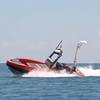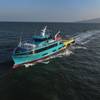The Increasing Importance of Preventative Maintenance
Likewise, Classification Societies (ABS, DNV and Lloyds) are accepting approved Preventive Maintenance Programs to replace special Continuous Machinery Surveys with only random inspections of such machinery.
Additionally the format of the Preventive Maintenance Program is suitable to be used in conjunction with ISO 9000 certification.
In other words, IMO, USCG, ABS, NDV and Lloyd's as well as ISO 9000, are in harmony preserving efficiency, safety and security. A Preventive Maintenance Program is the key to take advantage of the evolution that is taking place in the Marine and Offshore oil industries regarding Maintenance, Safety and Security.
Furthermore, the standards of other safety related organizations such as Occupational Safety and Health Administration (OSHA) has recently been sanctioned to be applicable to uninspected vessels. A requirement that is emphasized is the record keeping and documentation activities, which is the basis of a Preventive Maintenance Program.
Through the International Maritime Organization (IMO), the governments of the majority of the world's maritime nations have established conventions incorporating regulations for the protection of life, property and the environment (SOLAS, MARPOL, Loadline, tonnage, etc.).
The IMO has implemented an International Safety Management Code (ISM) adopted by IMO Resolution A 741 (18) and IMO resolution A 788 (19) which is a Quality Assurance (QA) program for the safe operations of ships and for pollution prevention and offshore installations such as:
• Floating Production Platforms
• Floating Storage Units
• Mobile Offshore Drilling Units (MODU's)
• Flotels
• Floating Production, Storage and Operations Unit (FPSO)
This code applies to both operator and contractor and should be considered when implementing a Safety Management System (SMS).
A SMS consists of a structured and documented system enabling company personnel to effectively implement the company safety and environmental protection policy.
A Safety Management Manual (SMM), itself in compliance with the requirements of the ISM code, is the document that contains, describes and implements the SMS.
The ISM code requires that a procedure be established to ensure that the ship is maintained in conformity with the provisions of relevant rules and regulations and with any additional requirements which may be established by the owner/operator.
Under these maintenance requirements the ISM emphasizes the need for documentation, reports or record keeping.
The owner/operator should establish procedures in SMS to identify equipment and technical systems the sudden operational failure of which may result in hazardous situations. The SMS should provide for specific measures aimed at promoting the reliability of such equipment or systems.
The Role of the USCG
Regarding maintenance of the ship and equipment, the U.S. Coast Guard Guide for meeting the requirements of the ISM code indicates: Vessels should have a system to record tests, inspection and periodic maintenance.
The system should indicate the date that the action was performed, results, corrective actions taken and next due dates.
"Safety Management Certificate" (SMC), a certificate indicating compliance with requirements by a given convention, can be issued only by the government of the Flag Administration which has signed the appropriate convention/code.
Other organizations can issue a "Document of Compliance (DOC) indicating the degree of compliance of the vessel with the appropriate convention/code.
The Role of the Classification Socieites
The designated certification authority, such as ABS, DNV or Lloyds, is approved by the U.S. Coast Guard and will audit the implementation of the SMM before issuing the Safety Management Certificate (SMC).
"Audit" means a systematic and independent examination to determine whether the SMS activities and relating results comply with the planned arrangements and whether these arrangements are implemented effectively and are suitable to achieve objectives.
The International Standards Organization (ISO)
ISO has also implemented a Quality Assurance (QA) program under ISO 9000 and ISO 9001, which covers every activity performed within a company.
ISO was organized in 1947 to standardize technical terms and measurements.
In recent years they have been developing quality standards initially to ensure that goods traded within the European community could be measured by a uniform set of quality assurance standards.
The ISO influence has become so great that ISO Certification now is a virtual requirement for doing business in Europe.
As this standard has become widely used, it has developed into the quality management system of choice in North America as well.
To be certified by ISO, a company has to be guided by professional consultants like our group through a rigorous training, including documentation and auditing processes.
The final step in the process is an intensive audit by an independent certification auditor. In the course of the audit, anyone in the company is likely to be quizzed by the auditor to see if he knows how to comply with the quality standard for his activity.
ISO 9000 identifies a company that participates in all aspects of its products or activities.
ISO 9001identifies a company that designs, manufactures and services its products.
Some companies are requiring contractors to be ISO 9000 certified before bidding on jobs, and also are requiring them to have an implemented formal maintenance system of their own.
Currently all vessels and Mobil Offshore Unites (MOU) going to a foreign port are required by the local authority to have both the vessel/MOU and the owner/operator to be ISM certified.
To obtain ISM/ISO 9000 certification, a company must establish and document procedures and standards required by ISM/ISO for various activities such as administration/ sales/ operations/ maintenance/safety.
Our group of consultants can implement a Maintenance system that directly addresses ISM and ISO 9000. It will provide the required model documentation for ISM and for the maintenance sector documentation for ISO 9000.
The required reports of Performed Maintenance and inspections are covered by our Monthly Management Reports.
The Maintenance System covers follow-up rectifications of deficiencies found on inspections.
About the Author
Hector Pazos and Carlos Monje are Naval Architects and Marine Engineers. Their associated Group of Consultants can help your company to implement a Computerized Preventive Maintenance System and/or to provide the required documentation for ISM and for the maintenance sector of ISO 9000. Contact Hector V. Pazos at (727) 784-8004 or (504) 367-4072 or by email: [email protected] or Carlos Monje at (504) 469-7508 or by email: [email protected]












